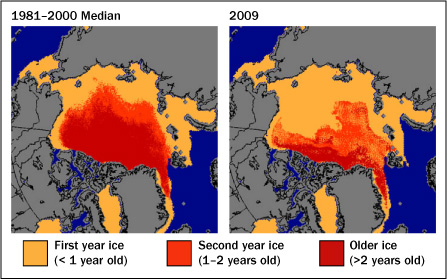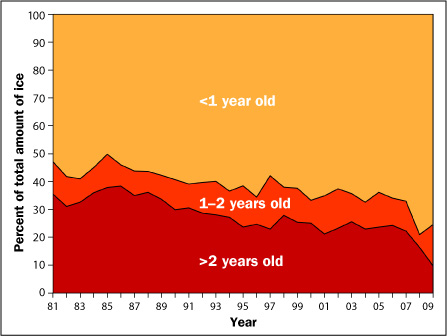The spring melting of the Arctic Ocean’s ice cap has already begun, and data suggest that the ice is more vulnerable than ever: The ocean area covered by ice is one of the lowest ever measured by satellites, and a record high fraction of that area is capped by thin, first-year ice that’s more prone to melt than older, thicker ice is.


Recent satellite images reveal that for March 2009 an average of 15.16 million square kilometers of Arctic seas were covered by ice, says Walt Meier, a remote sensing analyst at the National Snow and Ice Data Center in Boulder, Colo. That’s only 730,000 km2 more than the record low ice extent measured in the spring of 2006 but about 590,000 km2 — an area slightly smaller than the state of Texas — less than the long-term average, as tallied between 1979 and 2000, he announced during a press teleconference on April 6.
Although in the past year the ice extent has recovered slightly, its average thickness is way down, largely because much of this year’s ice formed just this last winter, Meier adds. While the average proportion of multiyear ice in Arctic seas is about 30 percent, this spring the proportion of ice older than 1 year old is a record low 9.8 percent. The region’s floating ice “is much younger and thinner compared to previous years,” Meier noted.
Thinner ice is more likely to melt over the course of a summer, says Ron Kwok, an analyst at NASA’s Jet Propulsion Laboratory in Pasadena, Calif. While multiyear ice is often three meters or more thick, first-year ice measures only two meters thick or less. In recent years, wind patterns have driven large amounts of multiyear ice from the Arctic Ocean into the North Atlantic, and winter refreezing hasn’t caught up with that ice loss, he commented at the press conference.
Although some small parts of the Arctic were cooler than normal this winter — including the Bering Sea, where ice extent actually increased this year — long-term trends for the entire region show an overall loss of ice, Meier notes. “We’ve lost about one-third of the ice cover that we had in the 1980s,” he says.






